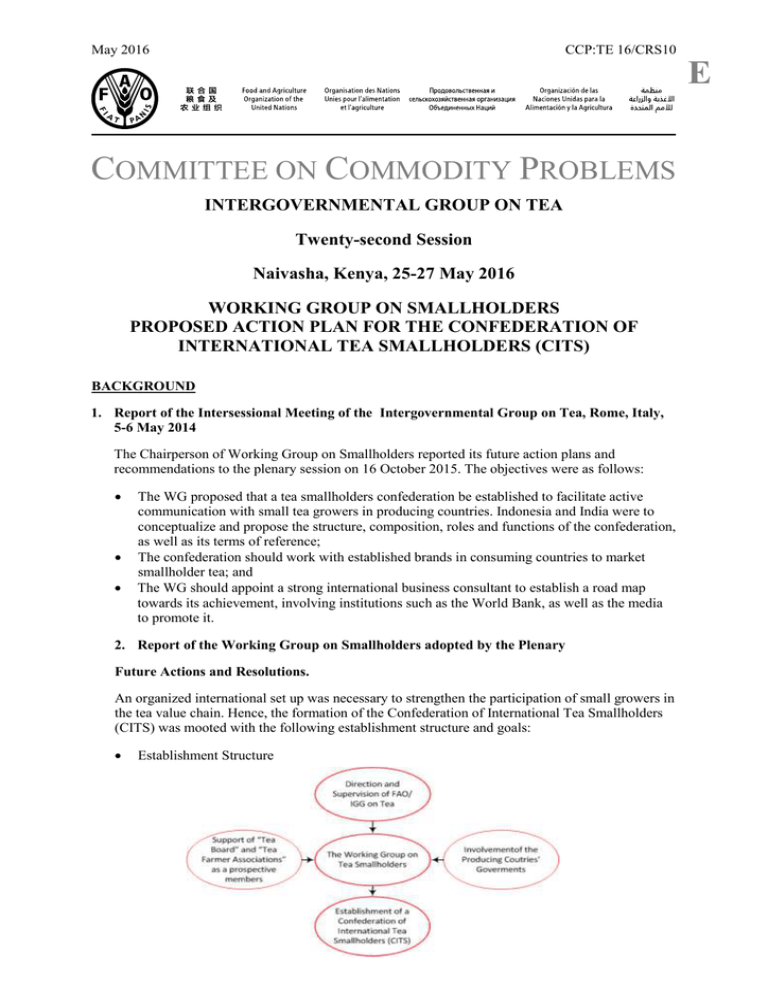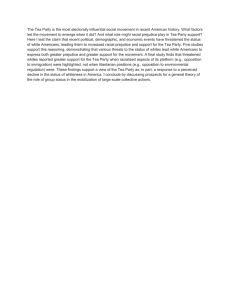E C P
advertisement

May 2016 CCP:TE 16/CRS10 E COMMITTEE ON COMMODITY PROBLEMS INTERGOVERNMENTAL GROUP ON TEA Twenty-second Session Naivasha, Kenya, 25-27 May 2016 WORKING GROUP ON SMALLHOLDERS PROPOSED ACTION PLAN FOR THE CONFEDERATION OF INTERNATIONAL TEA SMALLHOLDERS (CITS) BACKGROUND 1. Report of the Intersessional Meeting of the Intergovernmental Group on Tea, Rome, Italy, 5-6 May 2014 The Chairperson of Working Group on Smallholders reported its future action plans and recommendations to the plenary session on 16 October 2015. The objectives were as follows: The WG proposed that a tea smallholders confederation be established to facilitate active communication with small tea growers in producing countries. Indonesia and India were to conceptualize and propose the structure, composition, roles and functions of the confederation, as well as its terms of reference; The confederation should work with established brands in consuming countries to market smallholder tea; and The WG should appoint a strong international business consultant to establish a road map towards its achievement, involving institutions such as the World Bank, as well as the media to promote it. 2. Report of the Working Group on Smallholders adopted by the Plenary Future Actions and Resolutions. An organized international set up was necessary to strengthen the participation of small growers in the tea value chain. Hence, the formation of the Confederation of International Tea Smallholders (CITS) was mooted with the following establishment structure and goals: Establishment Structure 2 CCP:TE 16/CRS10 Proposed Goals of CITS 1) To provide a forum for the development of policies and solutions to strengthen the global tea smallholder sector by acting as a convener, catalyst and source of reference, so as to improve the consistency of tea policy-making on a global level. 2) Market access. To enhance market accessability by providing statistics, research studies and other information on the world tea economy, thereby reducing transaction costs to the benefit of all components of the tea supply chain and enabling economic decisions to be taken on the basis of accurate and timely data. 3) To encourage the development of communications, public outreach and dissemination of knowledge on the world tea economy, through project activities, microcredit programmes, workshops, training, and other forms of knowledge sharing; and seeking finance for these activities. 4) Sustainable tea smallholders sector. To promote the development of a sustainable global tea smallholder sector, thereby contributing to its environmental sustainability, as well as generating increased income and employment, and improved living standards and working conditions in member countries. In order to take forward the proposal, the support of a consultant is necessary. The issue that needs to be addressed in this regard is funding. The consultant should assist in developing a marketing arrangement with the help of producers’ and consuming countries’ associations involved in tea matters to market the teas of small grower sector directly, at least covering the cost of production. ACTION PLAN 1. Introduction Smallholders have a prominent place in tea sector. Smallholders, globally, constitute 70% in area and 60% in production. Core issue affecting the small holders globally is the price realisation. Experience of countries like Kenya, Sri Lanka etc in establishing small grower authorities have not satisfactorily helped in better price realisation. In most countries, quality is one main issue that needs to be addressed. More and more countries and large players are insisting on certification and therefore small holders too have no option but to fall in line. While certifying agencies ensure that the growers follow all statutory norms, adhere to the safety standards, pay the minimum wages prevailing in that region to the workers etc., there is no guarantee that they help in getting at least cost of production to the producers. In order to strengthen the small grower sector, it was felt necessary to have an organised International set up and in that direction formation of Confederation of International Tea Small holders (CITS) was mooted. CCP:TE 16/CRS10 3 2. Strategic Goals and Proposed Activities This includes: justifications for the adoption of the strategic goals; connections of the strategic goals and the major challenges faced by the world tea; and proposed priority actions to achieve the strategic goals. Goal 1 : To provide a forum for the development of policies and solutions to strengthen the global tea smallholder sector through actions such as : - Identifying priority issues, concerns and opportunities that affect the tea smallholder economy and advising on responses. Consultations and cooperation on teasmallholder policies and actions with Governments, the private sector and international organizations. Goal 2 : Enhancing accessability of the tea market and enabling economic decisions to be taken on the basis of accurate and timely data through actions such as: - Detailed statistical coverage of the tea value chain Research studies and reports on the market situation and trends and developments Goal 3 : Encouraging the development of communications, public outreach and dissemination of knowledge on the world tea economy through actions such as : - Defining teasmallholder development strategies - Sponsoring teasmallholder development projects - Supporting the establishment of microcredit and risk management programmes, especially for smallholders - Stimulating technology transfer and technical cooperation - Organizing workshops, training and other forms of knowledge sharing - Seeking finance for these activities Goal 4 : Promoting a sustainable tea sector through action such as : - Assisting Members in understanding and improving market structures and performance, in order to provide wider access to credit and risk management instruments for tea smallholders, in this way, promote an increase in the share of producing countries in the tea value chain. - Implementing measures to improve quality. - Taking actions to increase consumption and market development. - Disseminating information about sustainable techniques and the efficient use of environmental resources. - Promoting studies and projects that will help to identify the potential for carbon sequestration by tea farms as a complementary source of income for tea farmers in the form of carbon credits. 3. Monitoring and Evaluation A monitoring and evaluation system will be established to examine and assess progress and outcomes of the implementation of the Action Plan. Monitoring of actions will be conducted by a Secretariat, including regular progress reports on the implementation of the Plan. An evaluation of the Action Plan will be conducted during the year, wherein progress and achievement of its outcomes will be measured with qualitative and quantitative indicators The following summary model provides an overview of the required monitoring and evaluation framework, including potential indicators. 4 CCP:TE 16/CRS10 Goal 1 Goal 2 Goal 3 Goal 4 Indicators a. Meetings of the Council and other CITS bodies b. Missions and briefings on CITS activities c. Membership of the CITS d. Holding of World Tea Conferences e. Participation in events organized by the international tea trade and relevant international organizations f. Publication and dissemination of policy documents a. Updated statistics on tea trade, production, prices, consumption, etc. b. Statistical quality c. Studies and reports on relevant aspects of the world tea economy d. Market expansion and diversification a. Number and value of projects screened, under implementation and concluded b. Number of seminars, round-tables and workshops organized c. Inclusion of capacity-building, risk management, credit access and other relevant activities in projects and CITS events d. Publication and dissemination of information on the world tea economy a. Increased awareness of sustainability issues b. Increased use of sustainable practices c. Dissemination of information about tea and health issues d. Action Plan to encourage increased tea consumption and market development e. Volume of consumption in tea exporting countries f. Implementation of tea quality standards 4. Proposed Organizational Structure of CITS This Action Plan provides orientation on measures to attain the goal of the CITS. This work will be accomplished by the Organization through the various CITS bodies, the Secretariat and Members themselves. The CITS is proposed to be under the auspices of FAO / IGG on Tea. CCP:TE 16/CRS10 5 The CITS bodies should be able to use the contents of the Action Plan to assist in drafting policies and making recommendations about projects and other activities to the Council. In turn, the Action Plan will serve as a basis for the Council in its decision-making and in the evaluation of the activities of the Organization. The CITS Secretariat will use the strategic goals and priority actions as a reference framework for the development of the annual programme of activities, which constitutes the mechanism for the implementation of the Action Plan and matches the priorities of the CITS with the resources available for the period under consideration.



